Experimental Study on Hydrodynamic Characteristics of a Submerged Floating Tunnel under Freak Waves (I: Time-Domain Study)
Abstract
1. Introduction
2. Experiments
2.1. Experimental Equipment and Instruments
2.2. Model Parameters and Layout
2.3. Experimental Parameters and Methods
2.3.1. Experimental Parameters
2.3.2. Experimental Method
3. Results and Discussion
3.1. Free Decay Test and RAO Test
3.1.1. Free Decay Test
3.1.2. RAO Test
3.2. Dynamic Response Characteristics in Time Domain
3.3. Time Domain Amplification Effect of Freak Waves on Dynamic Response
3.3.1. Statistical Characteristics of Dynamic Responses under Different α1
3.3.2. Dynamic Response Amplification Coefficient in Time Domain
4. Conclusions
Author Contributions
Funding
Institutional Review Board Statement
Informed Consent Statement
Data Availability Statement
Conflicts of Interest
References
- Kharif, C.; Pelinovsky, E. Physical mechanisms of the rogue wave phenomenon. Eur. J. Mech. B Fluids 2003, 22, 603–634. [Google Scholar] [CrossRef]
- Kimura, A.; Ohta, T. Probability of the freak wave appearance in a 3-dimensional sea condition. In Proceedings of the 24th International Conference on Coastal Engineering. Part 1 (of 3), Kobe, Japan; ASCE: New York, NY, USA; Kobe, Japan, 1995; pp. 356–369, ISBN 08938717. [Google Scholar]
- Fochesato, C.; Grilli, S.; Dias, F. Numerical modeling of extreme rogue waves generated by directional energy focusing. Wave Mot. 2007, 44, 395–416. [Google Scholar] [CrossRef]
- Pelinovsky, E.; Talipova, T.; Kharif, C. Nonlinear-dispersive mechanism of the freak wave formation in shallow water. Phys. D Nonlinear Phenom. 2000, 147, 83–94. [Google Scholar] [CrossRef]
- Cui, C.; Pan, W.-B. Experimental Study on the Wavelengths of Two-Dimensional and Three-Dimensional Freak Waves. China Ocean Eng. 2023, 37, 154–164. [Google Scholar] [CrossRef]
- Gibson, R.S.; Swan, C. The evolution of large ocean waves: The role of local and rapid spectral changes. Proc. R. Soc. A Math. Phys. Eng. Sci. 2007, 463, 21–48. [Google Scholar] [CrossRef]
- Akhmediev, N.; Ankiewicz, A.; Soto-Crespo, J.M.; Dudley, J.M. Rogue wave early warning through spectral measurements? Phys. Lett. Sect. A Gen. At. Solid State Phys. 2011, 375, 541–544. [Google Scholar] [CrossRef]
- Rudman, M.; Leontini, J.; Cleary, P.; Sinnott, M.; Prakash, M. Rogue wave impact on a semi-submersible offshore platform. In Proceedings of the 27th International Conference on Offshore Mechanics and Arctic Engineering, OMAE 2008, Estoril, Portugal, 15–20 June 2008; OMAE: Estoril, Portugal, 2008; pp. 887–894, ISBN 9780791848227. [Google Scholar]
- Paul, P.W.; Rudman, M. Extreme wave interaction with a floating oil rig: Prediction using SPH. Prog. Comput. Fluid Dyn. 2009, 9, 332–344. [Google Scholar]
- Rudman, M.; Cleary, P.W. Rogue wave impact on a tension leg platform: The effect of wave incidence angle and mooring linetension. Ocean Eng. 2013, 61, 123–138. [Google Scholar] [CrossRef]
- Gu, J.Y.; Lv, H.N.; Yang, J.M. Dynamic response study of four column TLP in freak waves. Ocean. Eng. 2013, 31, 25–36. (In Chinese) [Google Scholar]
- Shen, Y.G.; Yang, J.M.; Li, X. Numerical investigation on the motion response of semisubmersible platform under extreme waves. Ocean. Eng. 2013, 31, 9–17. (In Chinese) [Google Scholar]
- Deng, Y.F.; Yang, J.M.; Xiao, L.F. Influence of wave group characteristics on the motion of a semisubmersible in freak waves. In Proceedings of the ASME 33rd International Conference on Ocean, Offshore and Arctic Engineering, San Francisco, CA, USA, 8–13 June 2014; pp. 56–64. [Google Scholar]
- Gao, N.; Yang, J.; Zhao, W.; Li, X. Numerical simulation of deterministic freak wave sequences and wave-structure interaction. Ships Offshore Struct. 2016, 11, 802–817. [Google Scholar] [CrossRef]
- Deng, Y.F.; Yang, J.M.; Xiao, L.F. An experimental investigation on the motion and dynamic responses of a semisubmersible in freak waves. In Proceedings of the 17th China Ocean (Coastal) Engineering Symposium, Nanning, China, 13–16 November 2015; pp. 741–749. [Google Scholar]
- Pan, W.; Zhang, N.; Huang, G.; Ma, X. Experimental study on motion responses of a moored rectangular cylinder under freak waves (I: Time-domain study). Ocean Eng. 2018, 153, 268–281. [Google Scholar] [CrossRef]
- Pan, W.; Liang, C.; Zhang, N.; Huang, G. Experimental study on hydrodynamic characteristics of a moored square cylinder under freak wave (II: Frequency-domain study). Ocean Eng. 2021, 219, 108452. [Google Scholar] [CrossRef]
- Pan, W.; Zhang, N.; Zeng, F.; Huang, G. Time-frequency domain characteristics on the dynamic response of a moored floater under a freak wave by wavelet analysis. Int. J. Offshore Polar Eng. 2021, 31, 160–168. [Google Scholar] [CrossRef]
- Yang, Z.; Li, J.; Xu, Y.; Ji, X.; Sun, Z.; Ouyang, Q.; Zhang, H. Experimental study on the wave-induced dynamic response and hydrodynamic characteristics of a submerged floating tunnel with elastically truncated boundary condition. Mar. Struct. 2023, 88, 103339. [Google Scholar] [CrossRef]
- Yang, Z.; Li, J.; Zhang, H.; Yuan, C.; Yang, H. Experimental study on 2D motion characteristics of submerged floating tunnel in waves. J. Mar. Sci. Eng. 2020, 8, 123. [Google Scholar] [CrossRef]
- Li, Q.; Jiang, S.; Chen, X. Experiment on Pressure Characteristics of Submerged Floating Tunnel with Different Section Types under Wave Condition. Pol. Marit. Res. 2018, 25, 54–60. [Google Scholar] [CrossRef]
- Klinting, P.; Sand, S. Analysis of prototype freak waves. In Coastal Hydrodynamic; ASCE: New York, NY, USA, 1987; pp. 618–632. [Google Scholar]
- Pei, Y.G. The Generation of Freak Waves and Its Behaviors; Dalian University of Technology: Dalian, China, 2008. [Google Scholar]
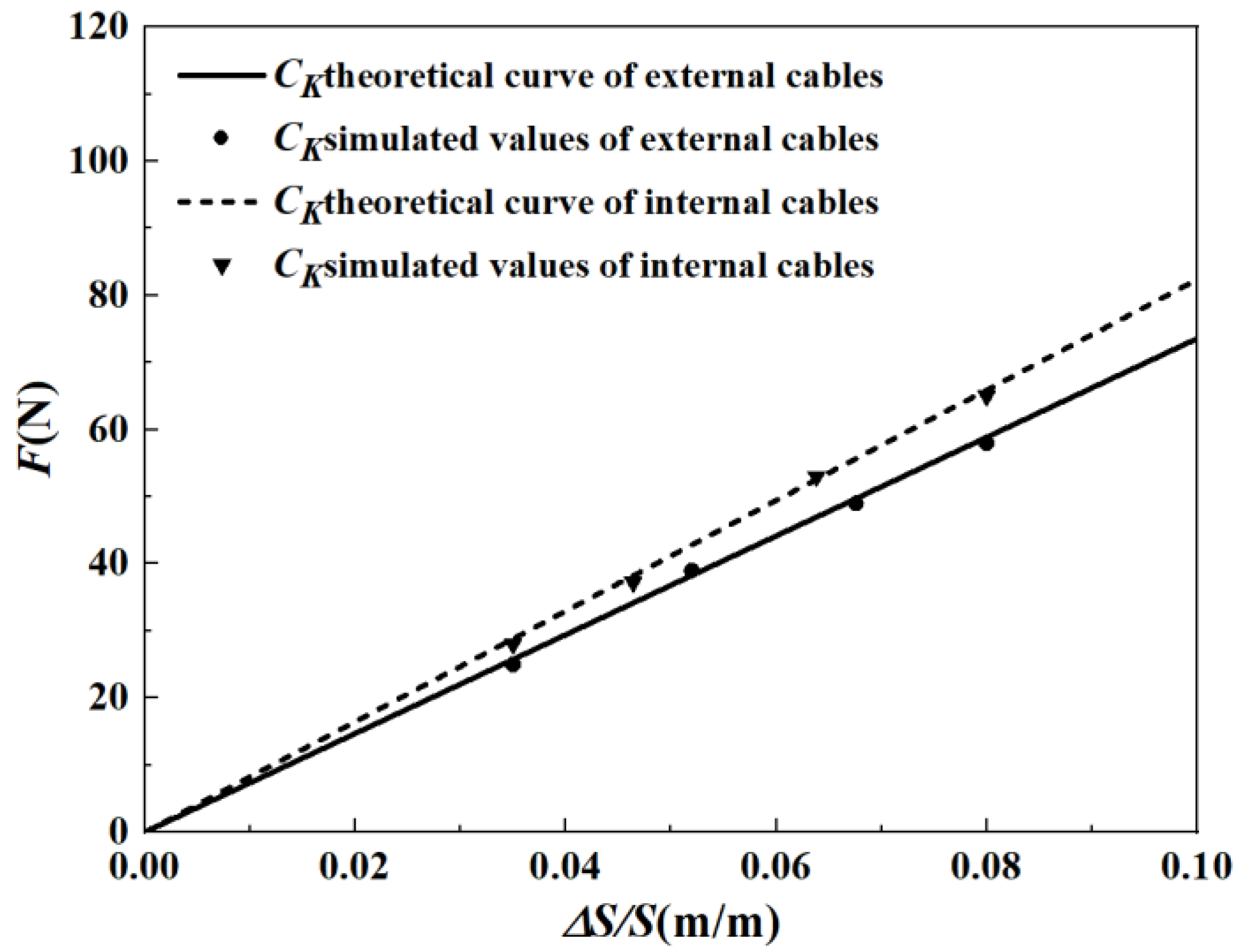

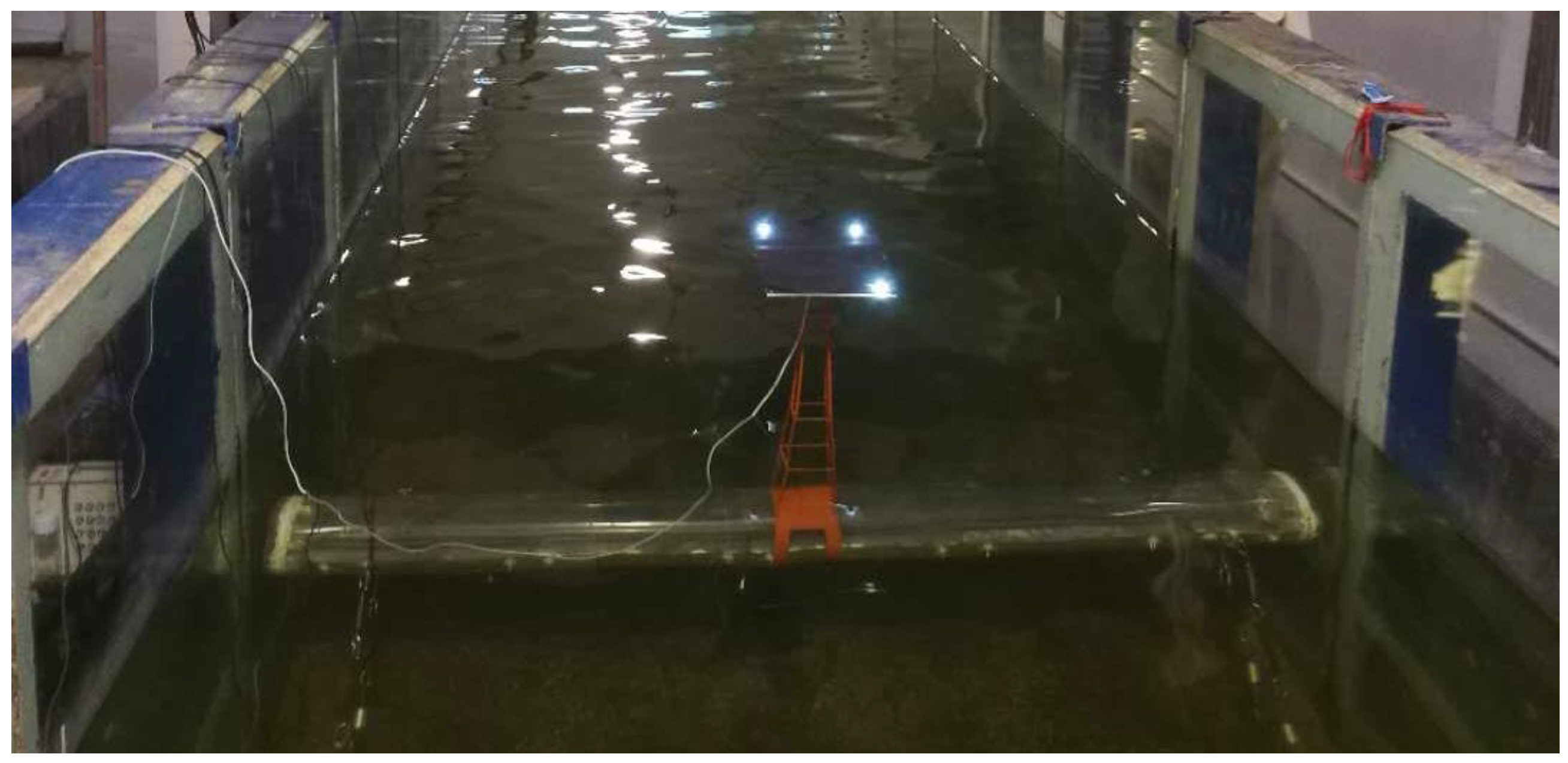
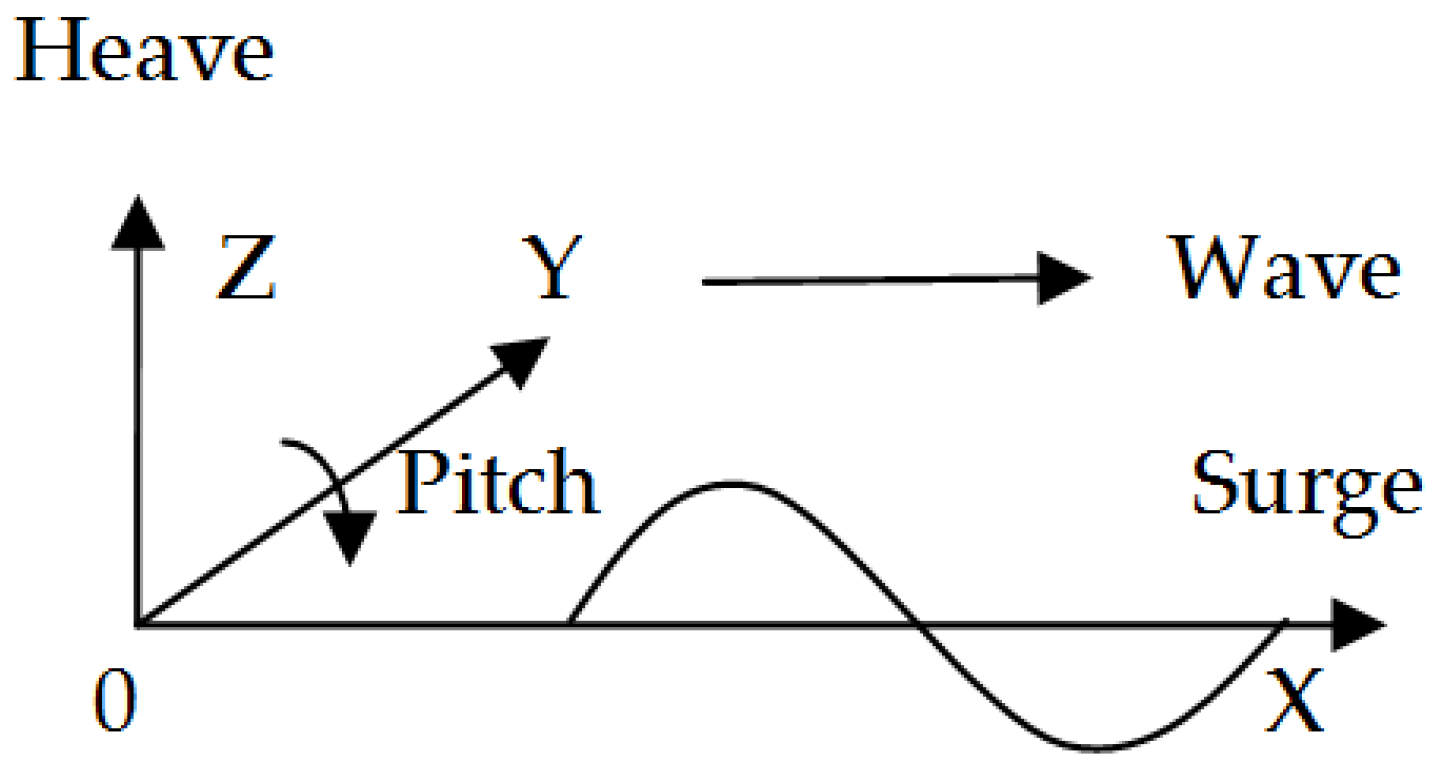

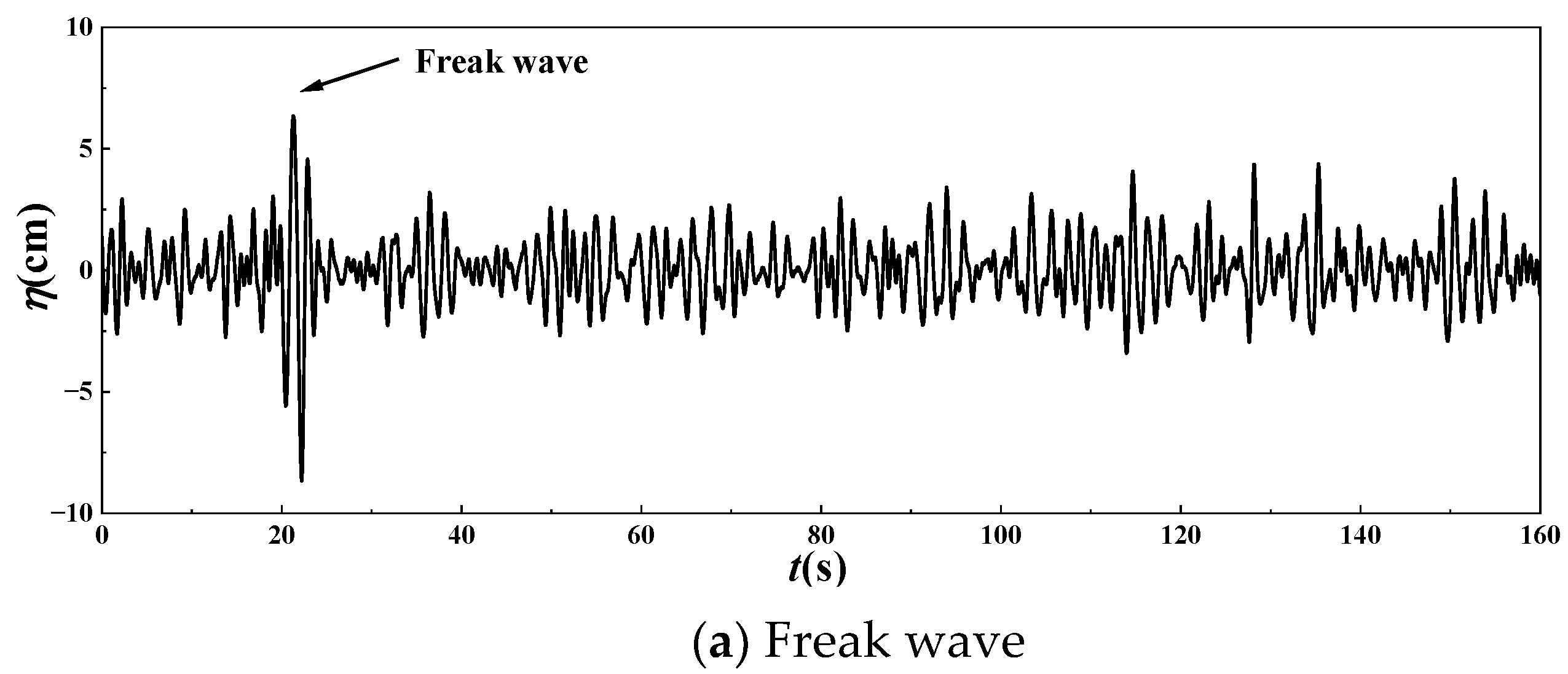
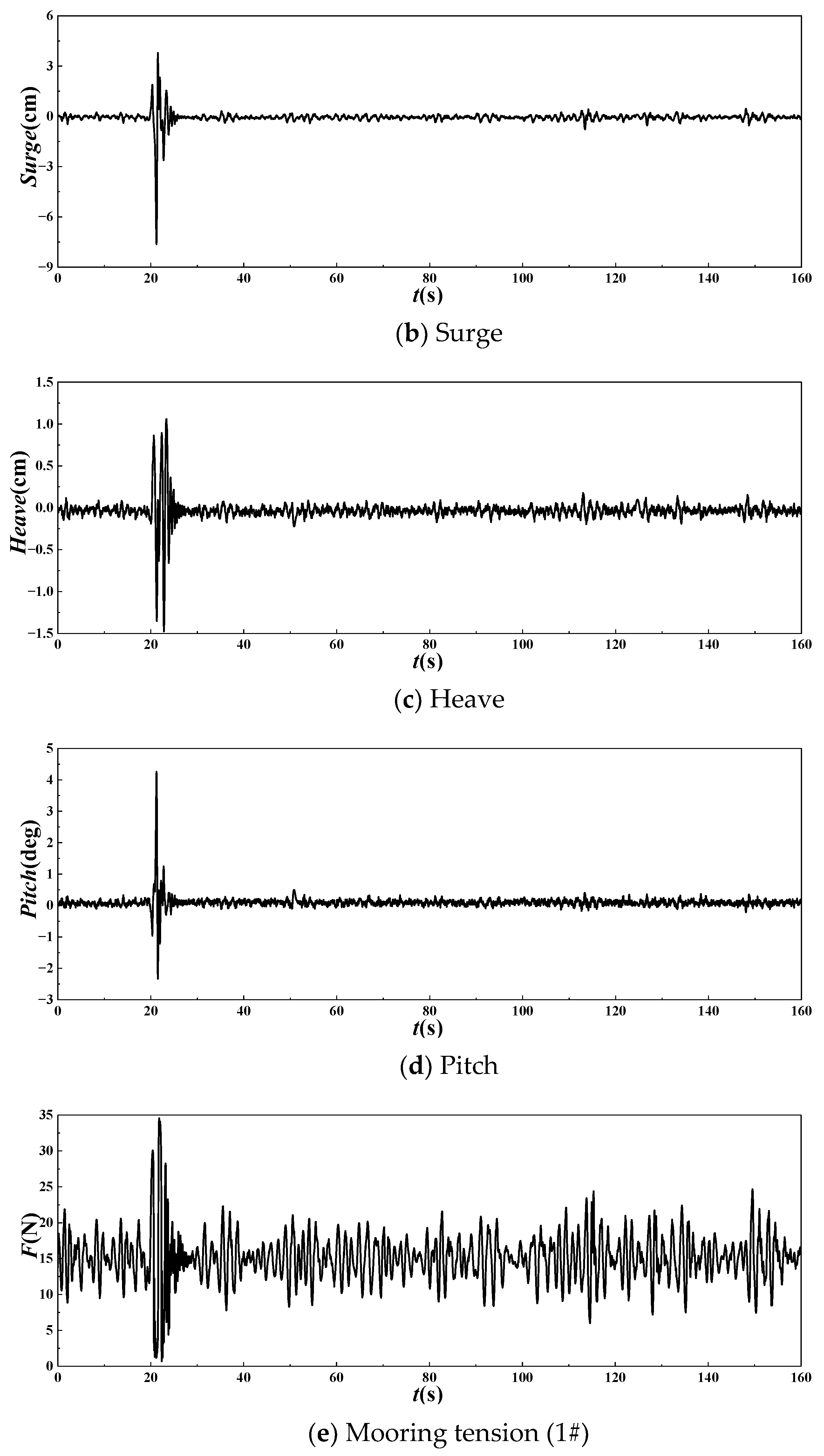
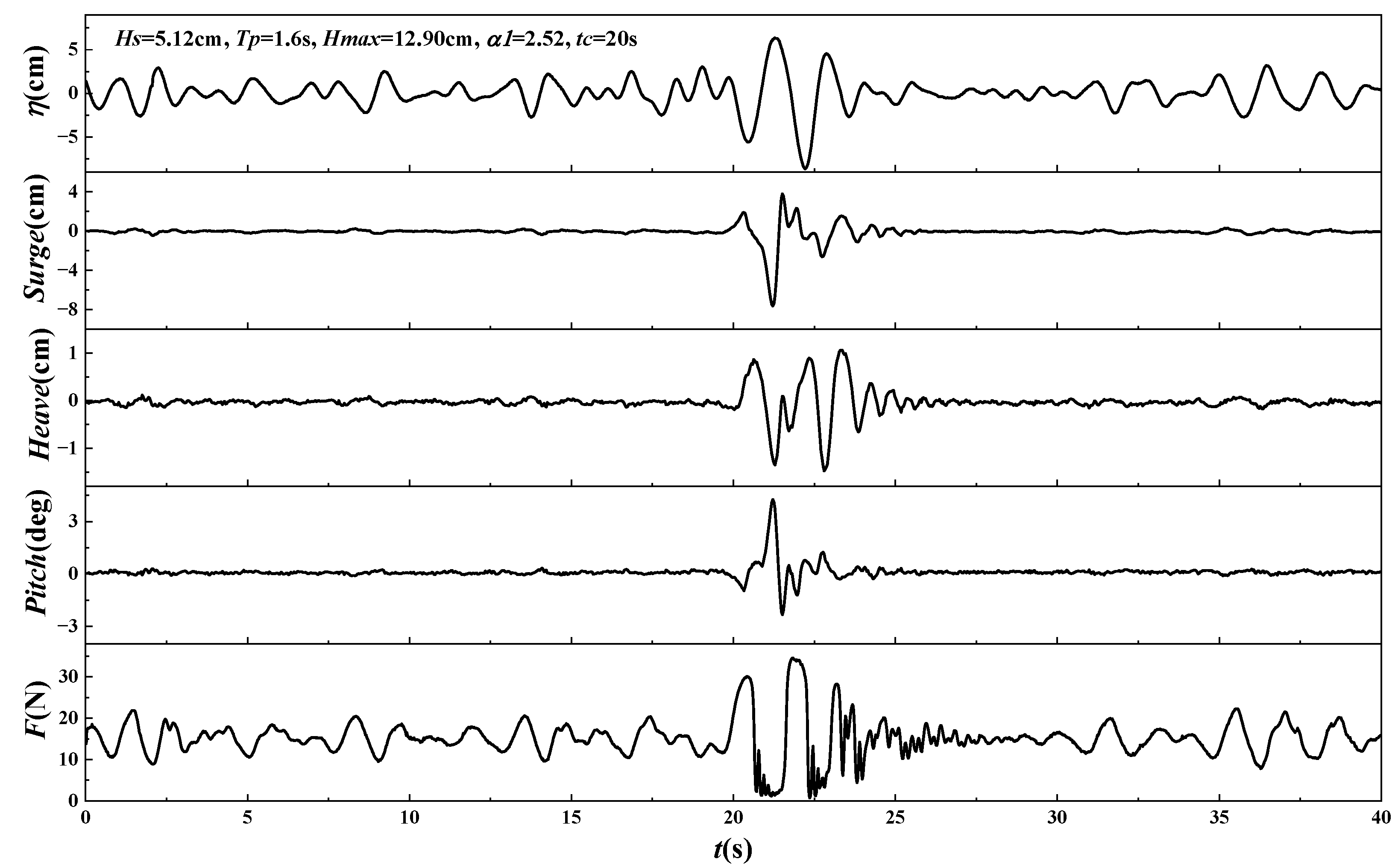
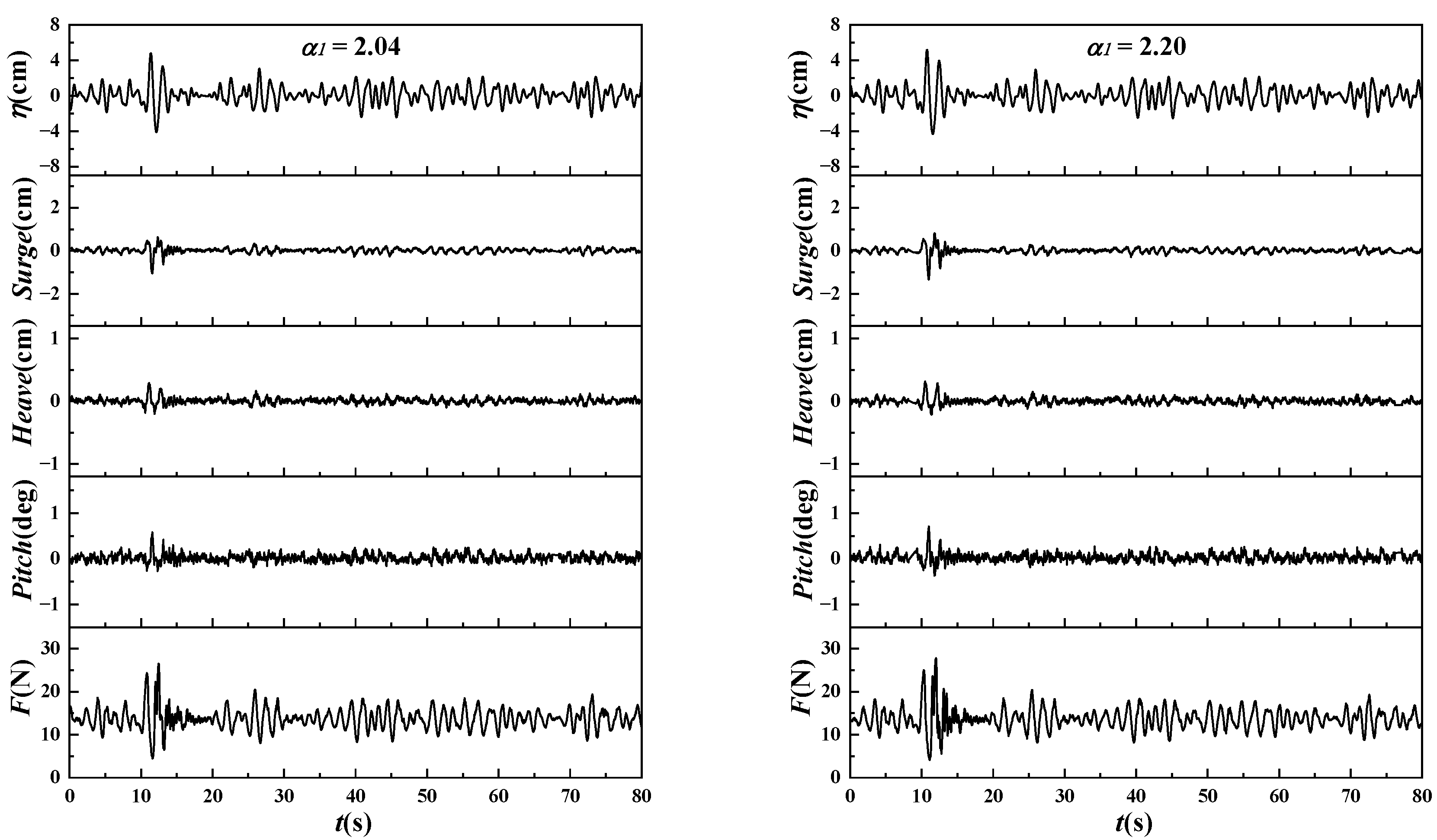
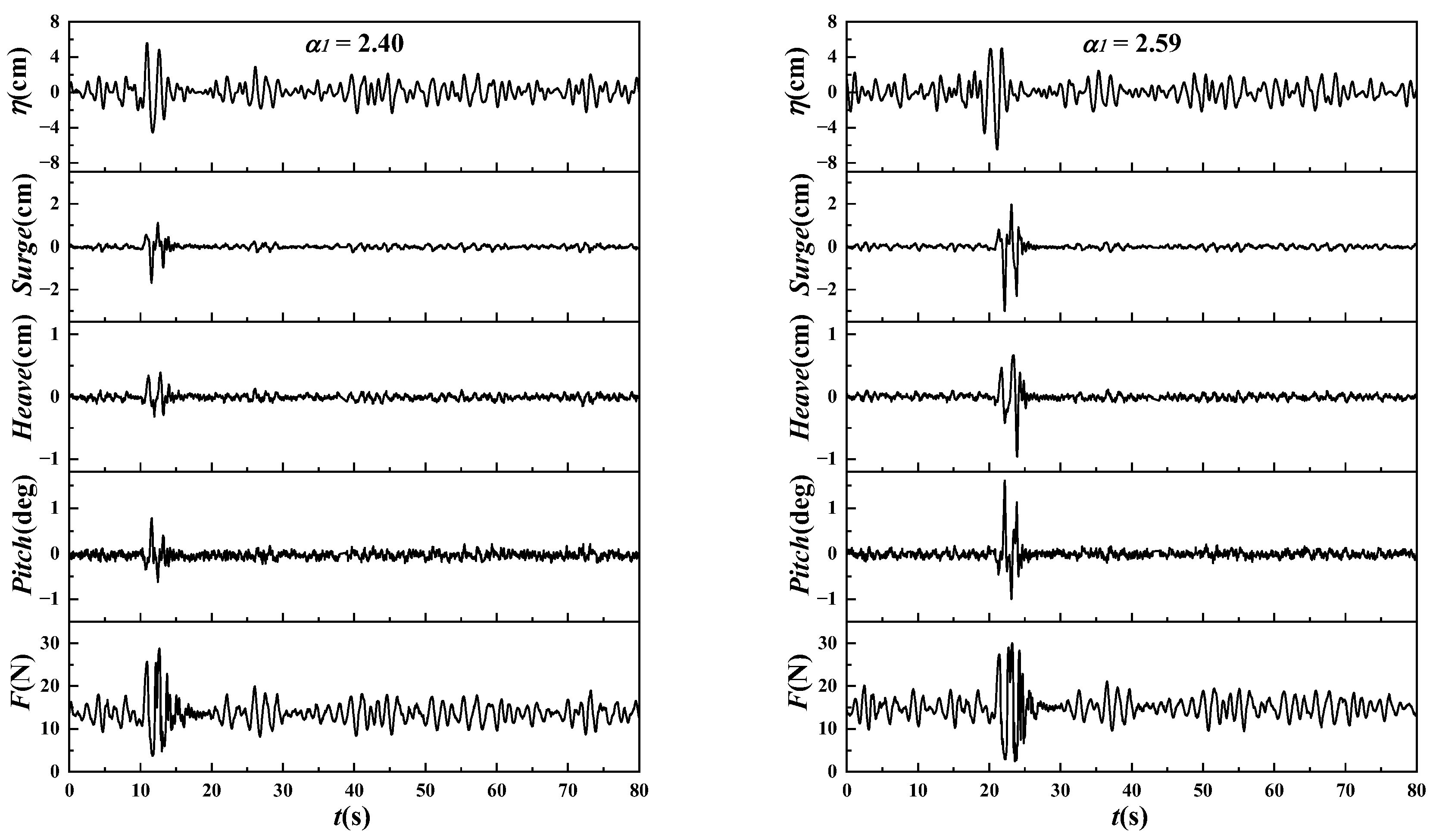
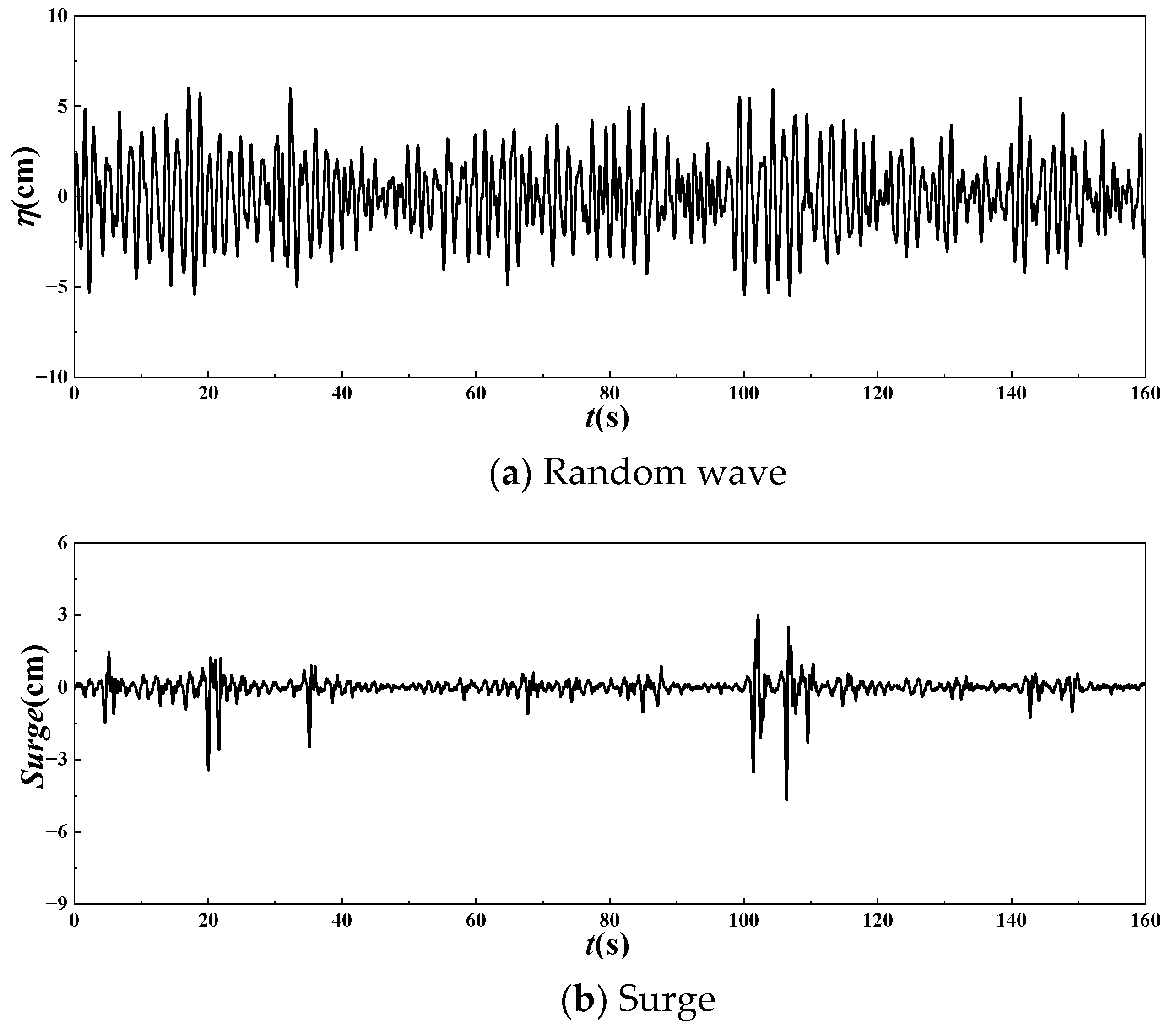
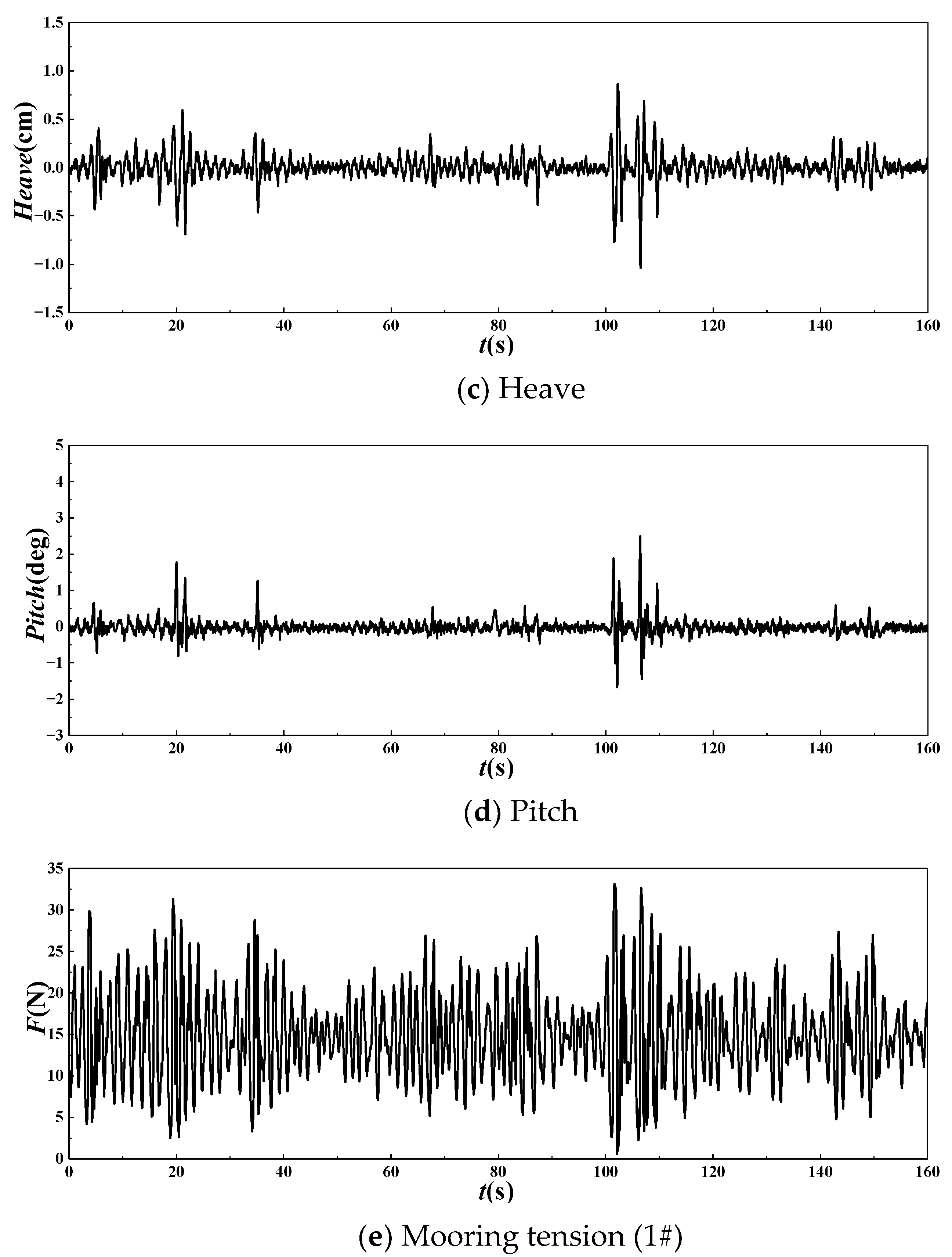


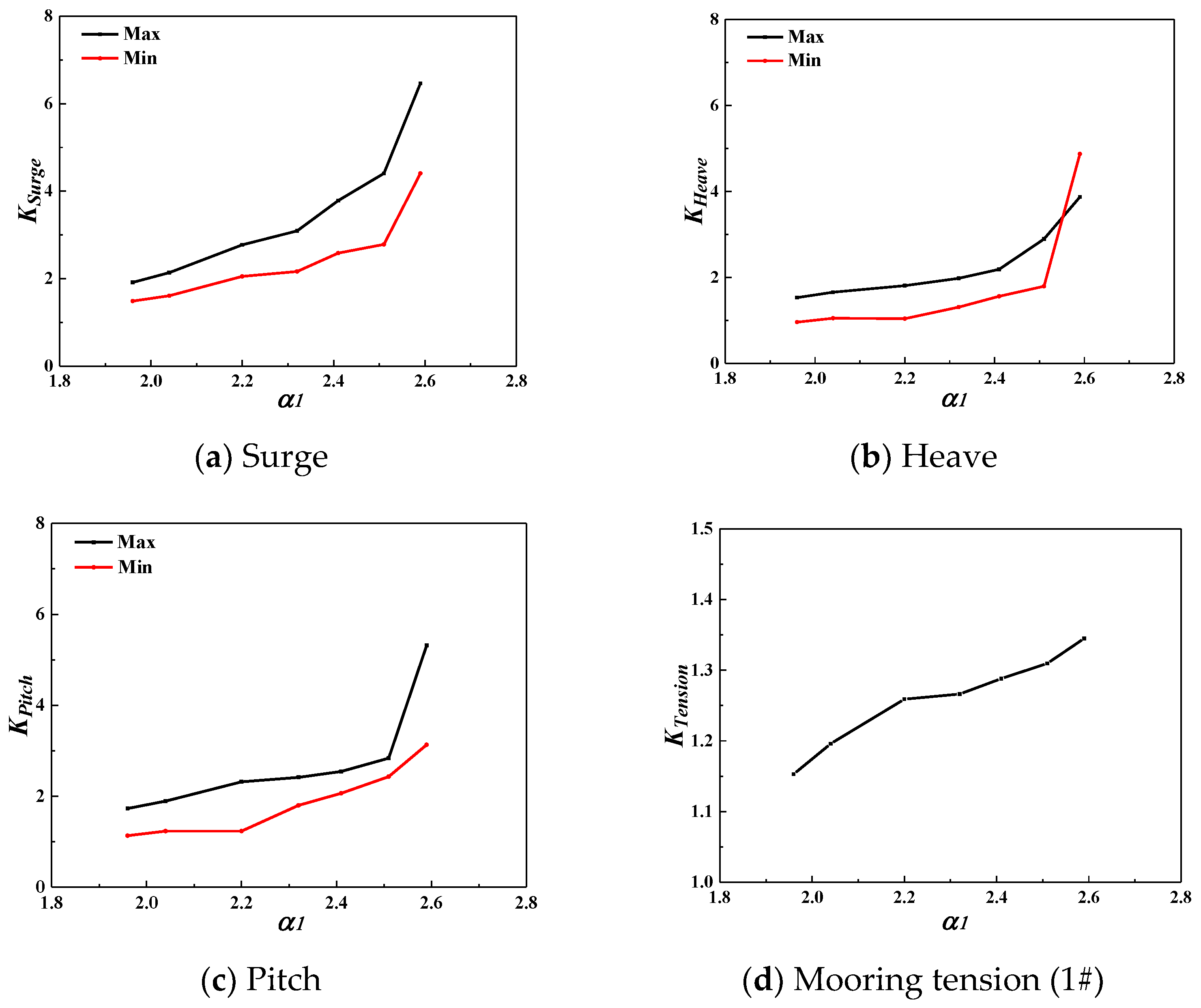
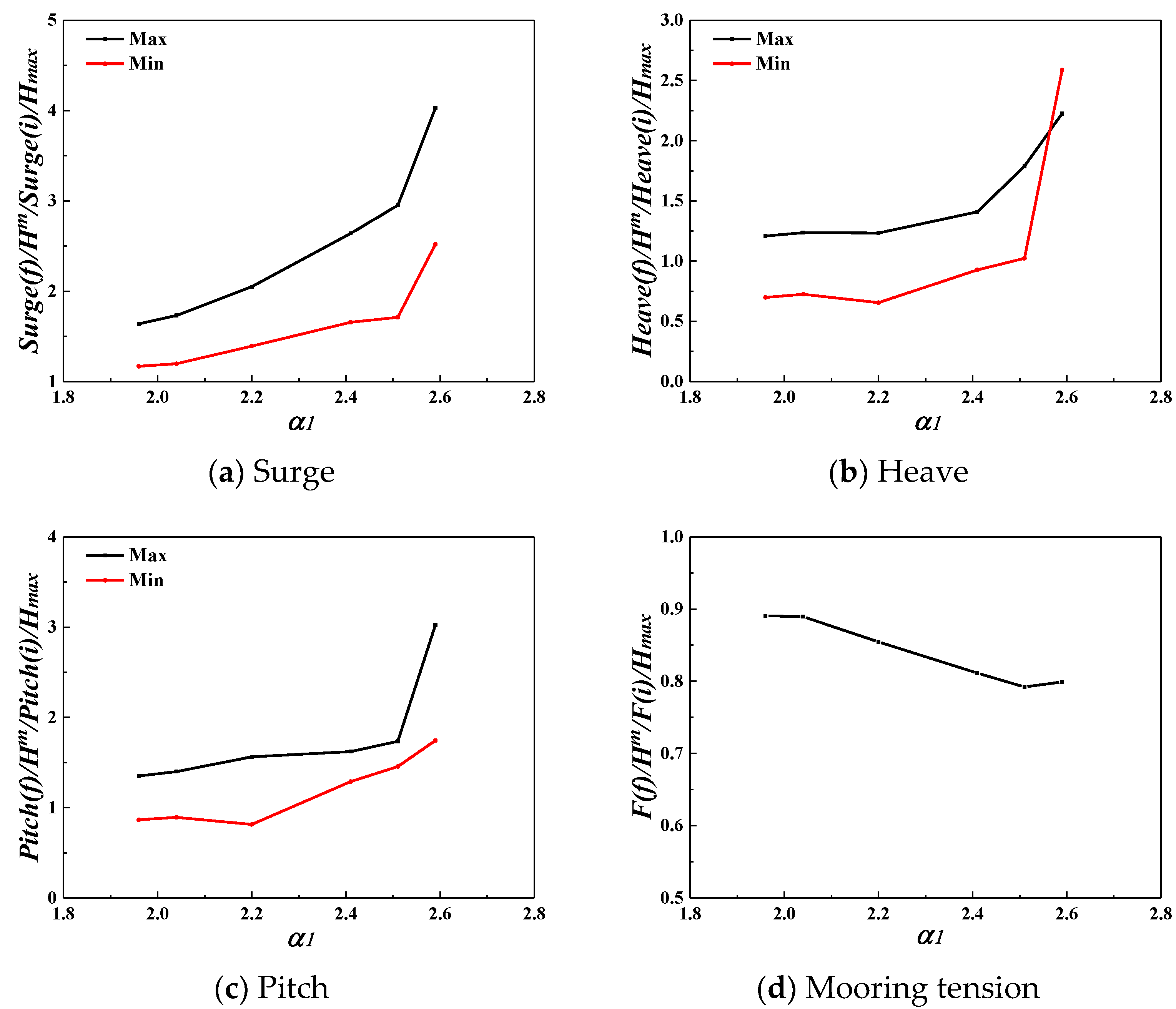
| Parameters | Symbols | Prototype | Unit | Model | Unit |
|---|---|---|---|---|---|
| Length | L | 120.0 | m | 200.0 | cm |
| Diameter | D | 12.0 | m | 20.0 | cm |
| Mass | M | 11232 | t | 52.0 | kg |
| Centre of gravity | B | 9.6 | m | 16.0 | cm |
| Centre of buoyancy | b0 | 12.0 | m | 10.0 | cm |
| Natural surge period | T0S | 9.90 | s | 1.29 | s |
| Natural heave period | T0H | 10.10 | s | 1.31 | s |
| Natural pitch period | T0P | 4.18 | s | 0.55 | s |
| Buoyancy weight ratio | BWR | 1.20 | - | 1.20 | - |
| Fixed Parameters | H (cm) | T (s) | Wave Length L (m) | Relative Submerged Depth d0/L |
|---|---|---|---|---|
| d =120 cm d0 = 42 cm d0/d = 0.35 F0 = 13 N | 4.0 | 0.8 | 0.99 | 0.360 |
| 1.0 | 1.56 | 0.231 | ||
| 1.2 | 2.24 | 0.161 | ||
| 1.4 | 3.02 | 0.119 | ||
| 1.6 | 3.84 | 0.094 | ||
| 1.8 | 4.67 | 0.077 | ||
| 2.0 | 5.49 | 0.066 |
| Fixed Parameters | Hs (cm) | TP (s) | Relative Wave Height | Relative Wave Period | Relative Submerged Depth d0/LP | α1 | |||
|---|---|---|---|---|---|---|---|---|---|
| Hs/d | Hs/d0 | TP/T0S | TP/T0H | TP/T0P | |||||
| d = 120 cm d0 = 42 cm d0/d = 0.35 F0 = 13 N | 4.0 | 1.6 | 0.033 | 0.095 | 1.25 | 1.23 | 2.96 | 0.109 | 1.90 |
| 2.04 | |||||||||
| 2.20 | |||||||||
| 2.41 | |||||||||
| 2.51 | |||||||||
| 2.59 | |||||||||
| Natural Parameters | Surge | Heave | Pitch |
|---|---|---|---|
| Natural period (s) | 1.28 | 1.30 | 0.54 |
| Equivalent damping | 0.11 | 0.09 | 0.22 |
| Hs (cm) | Tp (s) | α1 | Smax/Smax-1 | Hmax/Hmax-1 | Pmax/Pmax-1 | Fmax/Fmax-1 |
|---|---|---|---|---|---|---|
| 4.0 | 1.6 | 2.04 | 2.23 | 1.71 | 1.95 | 1.24 |
| 2.20 | 2.81 | 1.88 | 2.50 | 1.29 | ||
| 2.40 | 3.52 | 2.69 | 3.39 | 1.36 | ||
| 2.59 | 6.69 | 7.68 | 6.19 | 1.35 |
Disclaimer/Publisher’s Note: The statements, opinions and data contained in all publications are solely those of the individual author(s) and contributor(s) and not of MDPI and/or the editor(s). MDPI and/or the editor(s) disclaim responsibility for any injury to people or property resulting from any ideas, methods, instructions or products referred to in the content. |
© 2023 by the authors. Licensee MDPI, Basel, Switzerland. This article is an open access article distributed under the terms and conditions of the Creative Commons Attribution (CC BY) license (https://creativecommons.org/licenses/by/4.0/).
Share and Cite
Pan, W.; He, M.; Cui, C. Experimental Study on Hydrodynamic Characteristics of a Submerged Floating Tunnel under Freak Waves (I: Time-Domain Study). J. Mar. Sci. Eng. 2023, 11, 977. https://doi.org/10.3390/jmse11050977
Pan W, He M, Cui C. Experimental Study on Hydrodynamic Characteristics of a Submerged Floating Tunnel under Freak Waves (I: Time-Domain Study). Journal of Marine Science and Engineering. 2023; 11(5):977. https://doi.org/10.3390/jmse11050977
Chicago/Turabian StylePan, Wenbo, Meng He, and Cheng Cui. 2023. "Experimental Study on Hydrodynamic Characteristics of a Submerged Floating Tunnel under Freak Waves (I: Time-Domain Study)" Journal of Marine Science and Engineering 11, no. 5: 977. https://doi.org/10.3390/jmse11050977
APA StylePan, W., He, M., & Cui, C. (2023). Experimental Study on Hydrodynamic Characteristics of a Submerged Floating Tunnel under Freak Waves (I: Time-Domain Study). Journal of Marine Science and Engineering, 11(5), 977. https://doi.org/10.3390/jmse11050977






